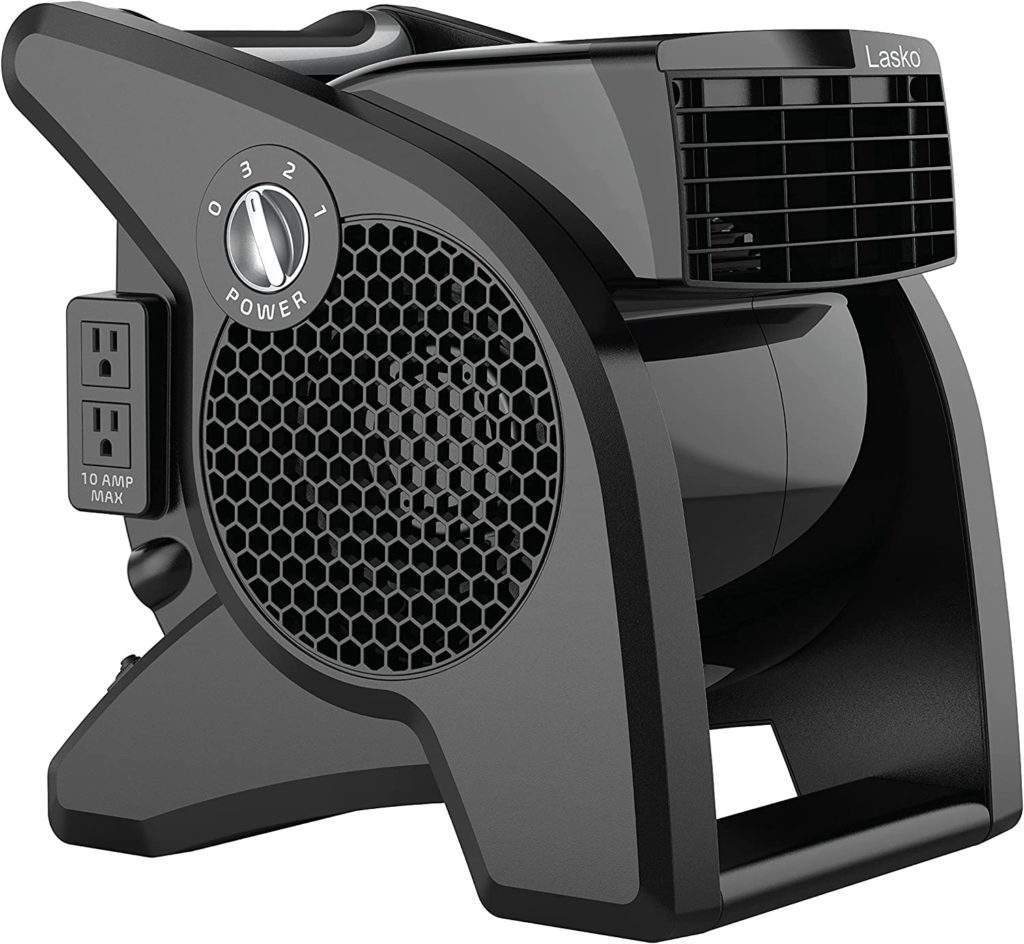Want to lounge outside on a hot summer day without feeling the heat? Outdoor fans make being outdoors comfortable if you know what to look for.
When it comes to outdoor fans, there are several styles available. The best one for your outdoor area will depend on how much breeze you need, the height of your ceiling, and the amount of space you have. Some can be hardwired into your electrical service, while others are simple plug-and-play models ready right outside the box.
When shopping for outdoor ceiling fans, you may want to consider what options are necessary for you. Will you require one that mists, oscillates, or has a remote control? You will also need to consider an outdoor fan that matches the style and décor of your home.
Guide to the Best Outdoor Fans
For those who believe that you can use any indoor fan outside, the answer is, please don’t. There is a distinction between indoor fans and ones you can use outside. Outdoor fans need to be damp- and-wet rated because of the changing weather. Even if the space is covered or won’t receive much moisture, you still need this type of fan.
Outside, there are too many variables to consider, along with different environmental conditions. Using a fan not equipped for the outdoors can damage the fan as it cannot handle moisture lurking in the air – even in covered areas.
You should note that you can use many ceiling fans for outdoor and indoor purposes. However, it must have a proper rating if you are using any fan for the outside.
What Constitutes a Good Outdoor Fan?
The best outdoor fans are those that fit the space and your budget. There are various models and styles suitable for any type of décor, so you will first need to discover what things are important to you and what features you need to incorporate into your space for good airflow.
- Sizing. You will need to calculate the square footage of your area first. If the room is less than 144 square feet, you will need a ceiling fan that is under 42”. Between 144-225 square feet, the fan size should range from 44”-50”. For a room that is between 225-400 square feet, you will need a fan that is 50+” and if it is over 400, then it needs to be over 62”.
- Rating. The fan needs to have a damp or wet rating. For dry areas or covered patio spaces, the fan can be wet- or damp-rated. In places with high humidity or rainfall, you will need one that is wet-rated so that it lasts.
- Wet-rated: These fans are tested and equipped to withstand locations with heavy rain, ocean breezes, ice, and snow. They will help you stay cool in a heat wave. Wet-rated fans are perfect for gazebos, sun-exposed decks, pergolas, or verandas.
- Damp-rated: These are great for covered patios, screened porches, lanais, or sunrooms. They are perfect for spaces not directly exposed to snow, rain, or water. They will handle slight humidity throughout the seasons.
- Dry-rated: Never use this type of fan outside. They are not designed for this purpose, and they can be dangerous. They don’t stand up to moisture or the seasonal fluctuations of temperature. When exposed to outdoor elements, they may experience mechanical issues.
- Style. Does this fan blend in with the rest of your décor? Fans can range from industrial appearances to rustic to classical. Whether you are installing them, mounting them, or just plugging them into place, they will need to match the style of the area.
- Environment. Salty air and wind speed will determine how well the fan functions. Salt spray will quickly cause a fan to corrode if you are close to the coast. Fans that are marine grade do better in these areas compared to a standard fan. For locations where there are gusts or high winds, find one designed for high-wind locations. They are better equipped to handle winds and won’t break, sway, or bend during extreme weather.
- Height. You will also need to consider the height of the installation surface if you are investing in a ceiling fan. If you have an area with low clearance with a ceiling height of 7.5’-8’, you may need a flush-mounted ceiling fan (hugger fan). Between 8’-9’, you can use an included downrod. These extensions allow you to lower the fan to where the breeze is more beneficial.
For other heights, use the following measurements:
- For a height of 10 feet, use a downrod between 12” and 18”.
- For a height of 11 feet, use a downrod between 18” and 24”.
- For a height of 12 feet, use a downrod between 24” and 36”.
- For a height of 13 feet, use a downrod between 36” and 48”.
- For a height of 14 feet, use a downrod between 48” and 60”.
- For a height of 15 feet, use a downrod that is greater than 72”.
- Ceiling Fan Accessories. You can incorporate many accessories into your fan. There are ceiling fans that have pre-installed light kits. Others may have an optional light kit or several different options when it comes to light so that you can personalise its appearance.
Fans can come equipped with remote controls, but you can also make adjustments directly from the fan. Additionally, some fans will allow you to use a smartphone to work them. Smart fans are controlled through a mobile device and are advisable in areas that are hard to reach, like when installing them on a high ceiling.
You may also require angled adapters if your ceiling is not flat.
Fan Blade Size
If you want an outdoor ceiling fan, five-blade ones are common. However, there are fans with fewer blades available. Maximum fan sizes will not guarantee maximum airflow. Pitch, speed, blade span, and floor distance determine proper airflow. Here are some helpful tips to consider when choosing a blade size:
- Small spaces need small fans. If you have one that is too big, it will generate too much wind for you to be comfortable.
- You may need more than one fan for proper air circulation in large spaces.
- The space between the blades generates air movement. Search for fans with little overlap and shaped blades for good flow.
- Adding blades adjusts airflow but will make the fan noisier. The air will move and the motor will need to work harder to accommodate this new flow of air. Noisy fans tend to be distracting.
What Are the Best Types of Outdoor Fans?
You can use many fans outdoors. These range from ceiling-mounted to wall-mounted to towers to portable fans. There is something for every style and function imaginable.
Best Overall: Honeywell Belmar Outdoor Ceiling Fan
Type: Ceiling mount

The Honeywell outdoor fan is weather-resistant, damp-rated, and has bend-proof blades. The classic design of this fan will elevate the look of a patio, deck, gazebo, or porch, and the 52” five-blade fan contains three levels of speed, is dimmable, and has a reversible motor.
Pros:
- Tri-mount compatible
- Can cover bowl light
- Easy installation
- Lightweight
- Suitable for medium to large-sized rooms
Cons:
- Fan motor is a bit heavy
Best Budget: Hunter Cassius Ceiling Fan
Type: Ceiling mount

This Hunter fan is a mixture of modern charm and rustic design. This fan promotes excellent airflow with its 52” wingspan and reversible blades. It has a downdraft mode in summer, which rotates the blades counterclockwise, generating a nice breeze. The updraft mode will disperse warm air during winter.
Pros:
- Quiet motor
- Water-resistant
- Adjustable height
- Contains a dimmer
- Reversible blades
- Damp-rating makes it perfect for patios, covered porches, and sunrooms
Cons:
- Makes a humming sound
- Fan blades may be unbalanced, causing a wobble
Good For Small Spaces: Matthews Irene Outdoor Ceiling Fan
Type: Ceiling/Wall Mount

This fan may be smaller in appearance. However, thanks to a solid wood blade construction and powerful motor, it provides excellent airflow. The fans are 42” long and multispeed, providing six airflow levels. It contains high torque when used at a slow speed, conserving energy and providing a stronger airflow. This fan is for ceilings that are over seven feet high.
Pros:
- Wall mountable
- Reversible
- Controlled using a remote
- Variety of finish/color options
- Silent
Cons:
- Color may not be exactly as shown
Best Wall Mount: NewAir 20” Wall Mounted Outdoor Fan
Type: Wall Mount

Despite only having 20” blades, this fan is a very powerful unit. It is perfect for decks, patios, barns, and workshops. The look is more industrial, but it does contain a wall-mount bracket, making it adjustable.
Pros:
- Waterproof
- Three speeds
- Adjustable tilt head
- Durable construction with powder-coated steel
Cons:
- Switch may not work if it is damp
Best Misting Fan: Lasko Mistro Fan
Type: Corded Electric

If you need more power for cooling, this fan connects right to the garden hose to provide a refreshing mist, reducing your temperature to 25° F. This fan offers three speeds and will pivot 90° so that you can direct the mist flow and air.
Pros:
- Pivoting blower directs breeze
- Three fan speeds
- Great for cooling spaces, circulating air, drying wet floors/carpet
- Lightweight
- Easily maneuverable
- Small footprint
Cons:
- A bit noisy
- No remote control
- No oscillation
Best for Small Spaces: Lasko Living Tower Fan
Type: Corded electric

These fans are ideal for small spaces as they contain a small footprint. This fan is only 42”, contains a weather-resistant design, and is safe for rain. It has four-speed settings, including a quiet mode to use during the night or when you need things to be quiet.
Pros:
- Weather-resistant
- UV protection
- Oscillating fan with four fan speeds
- Long power cord (ten feet)
Cons:
- No remote control
- Angle of oscillation isn’t as wide as other models
Most Portable: B-Air Firtana Outdoor Fan
Type: Corded

This high-velocity, multipurpose floor fan easily meets cooling needs. It comes with three speed settings and is adjustable. It has a portable handle allowing you to carry it to multiple locations. The housing is easy to put together and take apart for easy maintenance. The housing of this fan is all metal and contains a heavy-duty construction.
Pros:
- Very maneuverable
- Lightweight
- Rotates 360°
- Can be mounted
- Circulates air well in a variety of spaces
Cons:
- Made of lighter materials so it may not be as durable
- Cord is shorter than other fans
Summary
When it comes to outdoor fans, be sure to first determine what you need. The essential thing to look for is one that has the proper size, blade size, and motor for your space. The next is to find something that has the features you need. Lastly, you need to find something that matches your décor. However, with so many options, this shouldn’t be difficult.
Outdoor Fans Other Than Ceiling Fans

For fans other than ceiling fans, be sure that it has enough power to cool off the space. Most homeowners decide to go with oscillating fans for improved airflow. These tend to be equipped with remotes or can be programmed. Again, be sure that it is suitable for the outdoors. Electricity and water will not mix in any situation.
You will also want to consider the size of the area. Not only do you want good air circulation, but for a small area, you may need one with a smaller footprint to save space.
Portability may also play a factor in the fan that you select. Do you want something to go in multiple areas or just one? This will factor into your decision. Other than these suggestions, most of the recommendations made above still apply.

